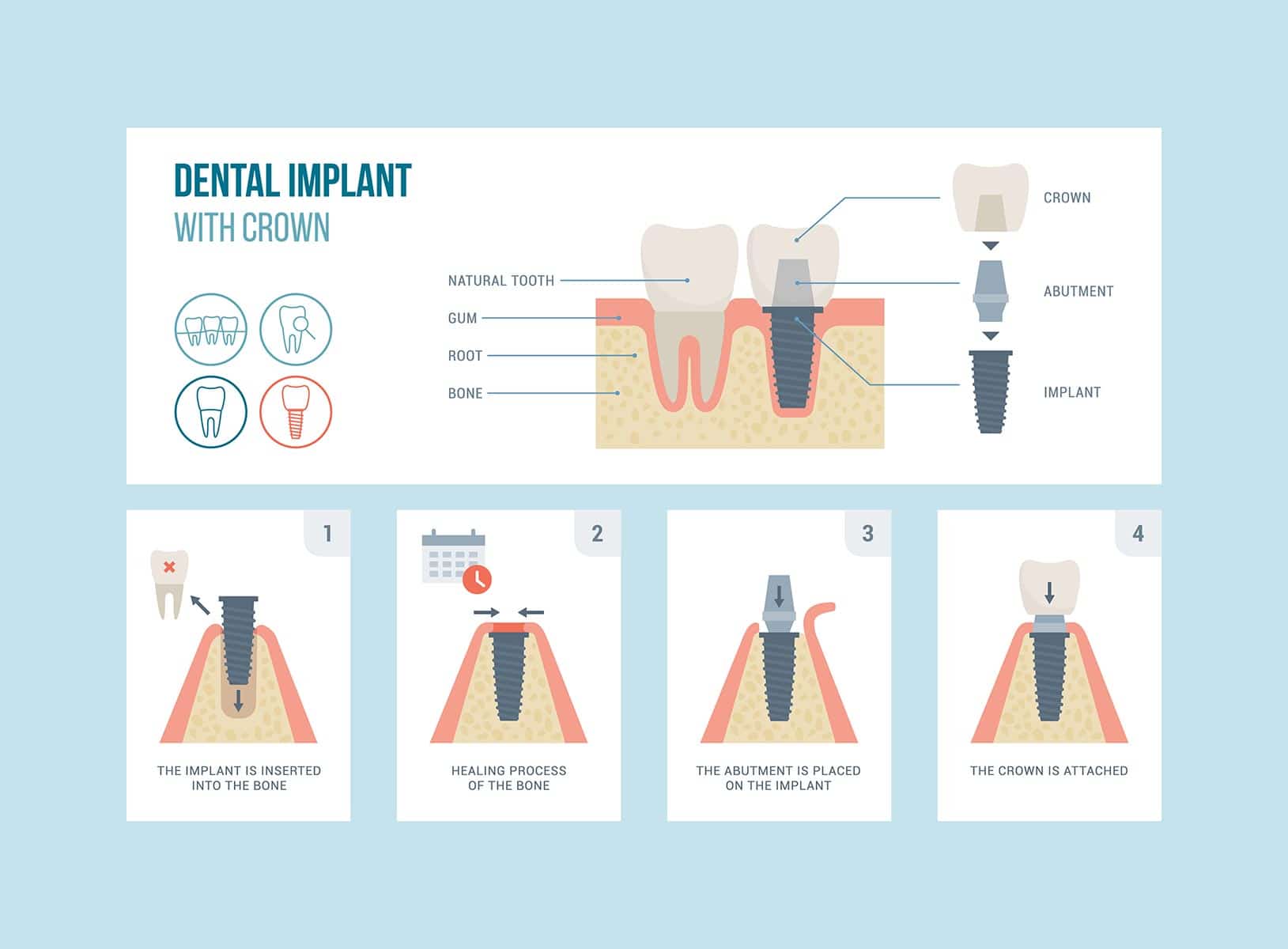
Getting dental implants involves a step-by-step process starting with an examination and consultation, where a dentist or oral surgeon assesses oral health and treatment goals. The surgical placement of the implant into the jawbone follows, done under local anesthesia. A healing period allows the implant to fuse with the bone. After integration, an abutment connects the implant to the replacement tooth, and a custom-made crown, bridge, or denture is secured onto the abutment. This comprehensive guide ensures a thorough understanding of the dental implant journey, providing a natural-looking and durable solution for missing teeth.
Dental implants are a popular and effective solution for replacing missing teeth. The process involves several steps:
- Initial consultation: Your dentist will examine your mouth and take X-rays to assess your eligibility for implants.
- Preparation: If necessary, any remaining damaged teeth will be removed, and your jawbone will be prepared for implant placement.
- Implant placement: A small titanium post will be surgically placed into your jawbone, serving as the foundation for the implant.
- Osseointegration: Over the next few months, your jawbone will naturally fuse with the implant, ensuring stability and durability.
- Abutment placement: Once osseointegration is complete, an abutment will be attached to the implant, connecting it to the replacement tooth.
- Placement of the crown: Finally, a custom-made crown will be placed on top of the abutment, completing the restoration process.
With proper care, dental implants can last a lifetime, providing you with a natural-looking and functional smile.

How Are Dental Implants Done Step by Step?
Dental implants are a popular and effective solution for replacing missing teeth. They provide a permanent and natural-looking solution that can improve both the appearance and function of your smile. But how exactly are dental implants done? In this article, we will break down the step-by-step process of getting dental implants, so you know what to expect if you are considering this treatment option.
Consultation and Treatment Planning
1. Initial Appointment
- Qualified Professional: Schedule a consultation with a qualified dentist or oral surgeon.
- Assessment: Dentist assesses oral health and candidacy for dental implants.
- Discussion of Goals: Treatment goals are discussed, and questions are addressed.
2. Personalized Treatment Plan
- Factors Considered: Number of implants, jawbone condition, and additional procedures like bone grafting are considered.
- Plan Creation: Dentist develops a personalized treatment plan based on the assessment.
Dental Implant Placement
1. Anesthesia and Incision
- Local Anesthesia: Administered to numb the implant area.
- Gum Incision: Small incision made to expose the jawbone.
2. Implant Placement
- Drilling and Insertion: Small hole drilled into the bone; biocompatible titanium implant inserted.
- Healing Cap: Cover screw or healing cap is attached to protect the implant during healing.
3. Osseointegration and Healing
- Crucial Healing Period: Implant integrates with the jawbone over several months.
- Post-Placement Care: Follow dentist’s instructions for oral care and attend regular follow-ups.
Abutment Placement and Crown Restoration
1. Abutment Attachment
- Gum Incision: Small incision to expose the implant.
- Abutment Placement: Connector piece attached to the implant with a small screw.
- Suturing: Gum tissue is sutured around the abutment for proper healing.
2. Crown Fabrication and Attachment
- Impressions: Impressions of the mouth are taken for a custom-made dental crown.
- Crown Design: Matched to natural teeth in size, shape, and color.
- Attachment: Crown attached to the abutment using dental cement or a screw.
- Adjustments: Necessary adjustments made to ensure a proper fit and bite.
Aftercare and Maintenance
1. Oral Hygiene and Check-ups
- Maintain Hygiene: Follow dentist’s instructions for brushing, flossing, and oral care.
- Regular Check-ups: Attend regular dental check-ups for ongoing monitoring.
2. Lifestyle Considerations
- Avoid Habits: Avoid smoking and excessive alcohol consumption.
- Signs of Issues: Be mindful of signs of infection or complications and contact the dentist if problems arise.
In conclusion, dental implants are a multi-step process that involves careful planning, precise placement, healing, and restoration. By following the step-by-step process and maintaining good oral hygiene, you can enjoy the benefits of a beautiful and functional smile for years to come. So, if you are considering dental implants, consult with a qualified dentist to determine if this treatment is right for you.
Key Takeaways: How Are Dental Implants Done Step by Step?
- Dental implants are a permanent solution for replacing missing teeth.
- The first step is a consultation with a dentist to assess if you are a suitable candidate.
- If you are a candidate, the next step is the placement of the implant into the jawbone.
- After the implant is placed, a healing period of a few months is required for the implant to fuse with the bone.
- Finally, a crown or prosthetic tooth is attached to the implant, completing the dental implant process.
Frequently Asked Questions:
Q: What is the first step in the dental implant procedure?
The first step in the dental implant procedure is a comprehensive examination and consultation with your dentist. During this initial visit, your dentist will evaluate your oral health, take X-rays or CT scans of your jawbone, and discuss your treatment plan with you.
Once your dentist determines that you are a suitable candidate for dental implants, they will schedule the surgery and provide you with pre-operative instructions to follow, such as avoiding food and drink for a certain period of time before the procedure.
Q: How are dental implants placed into the jawbone?
Dental implants are placed into the jawbone using a surgical procedure. First, your dentist will make an incision in the gum tissue to expose the underlying bone. Then, they will use specialized tools to create a small hole or socket in the jawbone, where the implant will be placed.
Once the implant is securely positioned in the socket, your dentist will close the incision with sutures and provide you with post-operative instructions for proper healing and care. Over time, the implant will fuse with the jawbone through a process called osseointegration, creating a stable foundation for the replacement tooth.
Q: How long does it take for the dental implant to heal?
The healing time for a dental implant can vary depending on several factors, including the patient’s overall health and the location of the implant. In general, it takes about 3 to 6 months for the implant to fully heal and integrate with the jawbone.
During this healing period, it is important to follow your dentist’s instructions and maintain good oral hygiene to promote proper healing. Your dentist may also provide you with a temporary restoration to wear while the implant heals.
Q: What is the next step after the implant has healed?
After the dental implant has fully healed and integrated with the jawbone, the next step is to place an abutment on top of the implant. The abutment is a small connector that attaches to the implant and serves as a support structure for the final dental restoration.
Once the abutment is in place, your dentist will take impressions of your teeth and gums to create a custom-made dental crown, bridge, or denture. This restoration will be designed to blend seamlessly with your natural teeth and provide you with a functional and aesthetically pleasing smile.
Q: How do I care for my dental implants after the procedure?
Caring for dental implants is similar to caring for natural teeth. It is important to maintain good oral hygiene practices, such as brushing twice a day, flossing daily, and visiting your dentist regularly for check-ups and cleanings.
In addition, you should avoid chewing on hard foods or using your teeth to open packages, as this can put excessive pressure on the implants. If you experience any issues or concerns with your dental implants, it is important to contact your dentist for evaluation and treatment.
Step by Step Guide to Your Dental Implant Procedure
Final Summary: How Are Dental Implants Done Step by Step?
Call or Book appointment online
:Ace Dental Care Alpharetta office: 678-562-1555 - Book Now
Ace Dental Care Norcross office: 770-806-1255 - Book Now
Disclaimer
This blog post was generated by artificial intelligence. The content of this post may not be accurate or complete, and should not be relied upon as a substitute for professional advice. If you have any questions about the content of this post, please contact us.
We are constantly working to improve the accuracy and quality of our AI-generated content. However, there may still be errors or inaccuracies. We apologize for any inconvenience this may cause.





